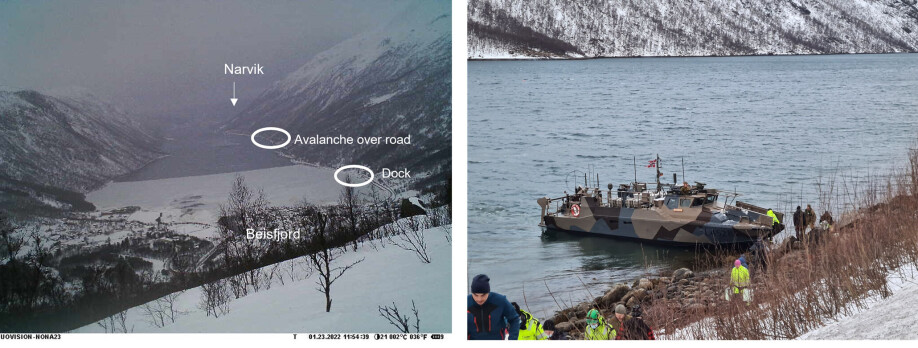THIS ARTICLE/PRESS RELEASE IS PAID FOR AND PRESENTED BY SINTEF - read more

Fjord ice can make places inaccessible
Norwegian fjord and coastal ice represent a potential security threat, as it may cut off entire communities from the outside world.
After a significant avalanche closed the road to Beisfjord in Northern Norway in February 2022, the community of approximately 700 people could only be reached by boat.
A military boat was sent in to help, but due to the presence of ice extending over one kilometre from the back of the fjord, access to a dock placed the previous summer was impossible.
As a result, the boat was forced to dock outside the town on a rocky coastline to provide supplies to residents.
Such events show why the behaviour of ice in subarctic fjords needs more attention, according to researcher Megan O'Sadnick at SINTEF Narvik. In her PhD-thesis, she provides the first comprehensive look at Norwegian subarctic fjord and coastal ice to address an intriguing gap in scientific knowledge.
Little research so far
Due to the influence of warm Atlantic water, larger fjords along the Norwegian coast are free from ice all year round. However, sea ice can form in the inner parts of fjords and in smaller fjord branches.
While a wide breadth of work examining mainland Norwegian fjords exists, little research has been conducted on sea ice in these locations. The focus has often been on water mass dynamics and their link to biological processes.
“With industry increasing in the North, a larger number of boats and people are being drawn to these areas. Understanding not only where ice may be present, but also the properties of that ice and the factors contributing to its formation, will better prepare northern communities for future development,” O’Sadnick says.
Analysis of satellite imagery
To fill the knowledge gap, an automated method was developed to estimate the ice extent in 386 fjords and other coastal areas along the coast of mainland Norway from 2001 to 2019 between February and May using optical satellite imagery.
The individual fjords were next grouped into regions to begin investigating the factors potentially driving ice formation including air temperature, snowfall, rainfall, and snowmelt.
“While the first, air temperature, was correlated to ice extent in some regions, this relationship as well as relationships to the two other weather variables examined were not consistent pointing to variations in the mechanisms driving ice formation,” O’Sadnick explains.
To enhance understanding of the properties of fjord ice including its crystal structure, bulk salinity and oxygen isotopic composition, ice samples were gathered from seven fjords located in Northern Norway during three winter seasons between 2017 and 2020. Possible correlations to temperature and snowfall were revisited in addition to river runoff illuminating further variations not only in ice extent between seasons, but also ice properties and the factors driving ice formation.
Additionally, the composition of water at the ice-ocean interface during ice growth was subsequently estimated.

Locals concerned about inaccessibility
The closure of the road leading into Beisfjord provides a clear example of how communities located in fjords and along the coast of Norway can quickly become inaccessible. The presence of ice in Beisfjord was an additional obstacle, limiting the area where boats could travel and the amount of coastline available to gain access to the town.
Only a week later, after the avalanche debris had been cleared, ice extent increased filling nearly the entirety of the fjord. Travel by boats without icebreaking capabilities was no longer viable, leading to concern within the community. If the road was closed again, they would need to depend on helicopters or wait for an ice breaker to arrive.
“Conversations are ongoing on how to ensure continuous access to Beisfjord through the winter, yet one thing is for certain, the presence of fjord ice greatly complicates any options that depend on access by sea,” O’Sadnick says.
As a result, solutions to how to keep Beisfjord safely accessible through winter are being explored, including more dependable but costly measures like the building of a tunnel.
Fjord ice should not go overlooked
The research shows that it is reasonable to surmise that the town of Beisfjord is not entirely unique in how it is impacted by the occasional presence of ice.
Sandnessjøen provides another example, with fjord ice being noted to halt winter-time shipments of building materials for a factory as early as the 1940s. To this day, fjord ice is still defined as a transportation challenge, blocking the only alternative route if the single road into town is closed during winter.
“Thus, Norwegian fjord and coastal ice should not go overlooked, and perhaps given more focus, because of its potential influence on local communities, industry, and the fjord environment,” O’Sadnick says. “More work remains, however, to improve our understanding not only of Norwegian fjord ice, but also of other regions where similar ice exists."
Reference:
Megan O'Sadnick: Ice in Norwegian subarctic fjords and coastal regions: An examination of ice formation, properties, and trends based on remote sensing and in situ data. Doctoral dissertation, UiT The Arctic University of Norway, 2022.
See more content from SINTEF:
-
How Svalbard is becoming a living lab for marine restoration
-
New study: Even brand-new apartments in cities can have poor indoor air quality
-
Fresh hope for patients with chronic inflammatory bowel disease
-
Testing a giant ship: May take five kilometres to stop
-
A robot is helping researchers hunt for the best cancer warriors
-
Locomotives that run on diesel can be electrified





































